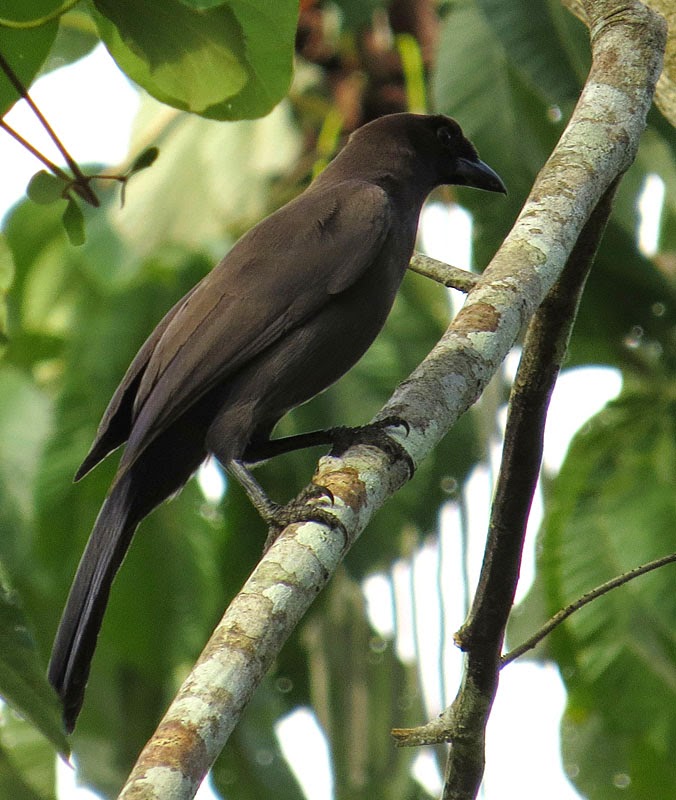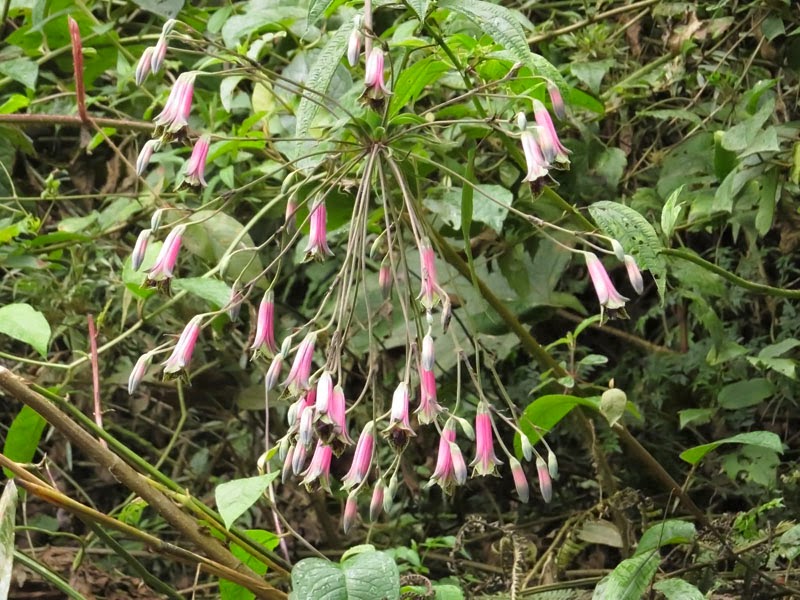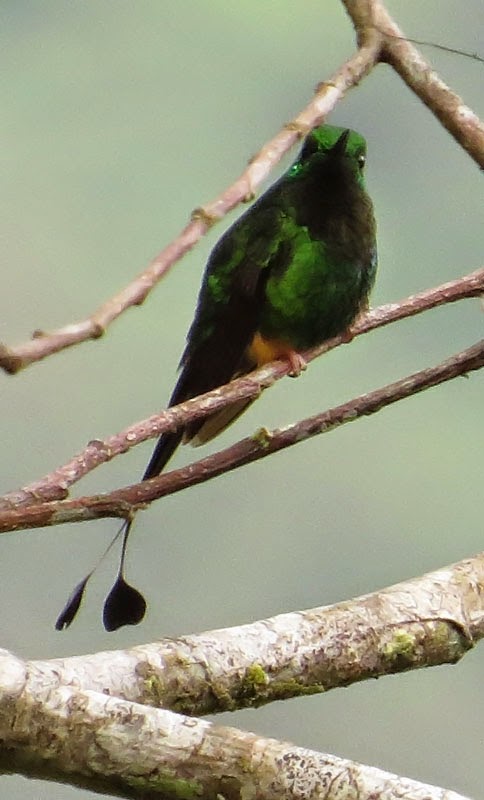This is the
4th in a series of blogs covering my most recent tour down the
Kosñipata Road and the Madre de Dios River in SE Peru from October 25-November
7. I apologize for the delay in posting, as I had to divert my attentions to a
party I threw this weekend that became rather a production.
Where I left
off last, Susanne and I arrived at the mid-elevation Manu Paradise Lodge for
just a single night. Today we are to continue our drive down in elevation from
4500 feet to Villa Carmen Biological Station at a much more tropical 1700 feet.
The first eight or so miles of this road are the most interesting though, and
we spent the first half of the day making many stops, walking stretches of the
road, and working mixed flocks. We also found a nice side trail with mushrooms.
I was up
early at the lodge, watching flocks of tanagers and a Mottle-backed Elaenia. I
spotted these mushrooms on the dead bamboo railing by the parking area, which
Susanne hadn’t shown me the afternoon before.
She later
became convinced that they must have sprouted up overnight after a good rain,
as she hadn’t seen them, and they were hard to miss. She identified them in the
genus Favolaschia, with this very distinctive
hymenium.
We drove
down the road, and I took the passenger seat to listen out the window for mixed
flocks. Within about 10 minutes of slow driving, I told Cesar to stop – I might
hear a bird or two. I thought we might get out for a minute and see what was
about, but we finally left this location after an hour and 50 minutes, having
logged 31 species of birds in a great mixed flock. One of the first birds I
heard was this Cinnamon-faced Tyrannulet, super cooperative when I played its
voice. Another bird we saw here was Foothill Antwren, which I only later
learned was a lifebird for me.
Farther down
the road, I was looking at my GPS for a waypoint I had created a four years ago.
There we found this female Green-fronted Lancebill, in exactly the same
location.
That’s
because hummingbirds frequently rebuild and reuse on the same nest each year. Here it was, on the very same ledge of
rock on a road cut.
This is the
same stretch of road that had an amazing diversity of butterflies on my tour a
month ago. But this Silky Purplewing, Eunica
carias tenebrosa, is one that I had missed. Each time it opened its wings
we could see the deepest purple flash, but every photo turned out black until I
overexposed it, and even then it’s hard to see.
This is a
Clearwing-mimic Queen, Lycorea ilione,
in the same tribe as the Monarch – there are a number of clearwings that look
extremely similar.
Speaking of
which, this is an Andromica Clearwing, Greta
andromica andania.
A very
widespread but always handsome brushfoot, the Rusty-tipped Page, Siproeta epaphus. I learned some German
butterfly group names to help spur Susanne to get interested in them. This is
in the family called Edelfalter.
I’ve known
for some time that skippers in German are Dickkopffalter; the thick-headed
butterflies, a very apt description. This one appears to be Pachyneuria lineatopunctata, which
doesn’t seem to have a common name. How about Line-spotted Thickvein?
There
weren’t many fungi right along the road, so we took a little side trail up a
stream known to butterfly people as Quebrada Quitacalzones (which could be translated
as “Take-your-panties-off Creek”). This lush drainage alone has a butterfly
list of something like 800 species, and the plant life is correspondingly
diverse. This lobelia relative looks closest to Centropogon congestus.
I assume
this tall wing-stemmed plant is in the family Piperaceae, but it bears little
resemblance to Piper or Peperomia, the only common genera here.
Anyone?
This looks
to be a Drymonia species, a very
large and amazingly diverse group of Gesneriads (members of the same family as African
Violet).
And here
Susanne finally got her fungus fix for the day, with lots of moist, dead wood
hosting a number of species. This Ellipticus
sp., pleasing fungus beetle (family Erotylidae; more to come in future
blogs) was munching away on one of them.
We drove on
to look for a wide spot to have lunch, and stopped when I saw a raptor fly out
of a tree next to the road. It was a Double-toothed Kite, and it landed next to
another one. While we watched them, one flew back to the tree next to the road
and started rearranging sticks in a nest! We enjoyed watching this for a few
minutes.
At the same
spot was this gorgeous Turquoise Emperor, Doxocopa
laurentia, yet another species I had missed on the butterfly tour a month
ago.
We finally
found a wide spot for lunch, but there was some bird activity including this
Masked Tityra.
We ended up
spending over an hour and half here, seeing 43 species of birds in a
never-ending mixed flock coming and going and making visits to fruiting trees.
A female Plum-throated Cotinga, Ocellated Woodcreeper, Red-billed Scythebill,
Bamboo Antshrike, Black-backed Tody-Flycatcher, and Yellow-crested Tanager were
highlights. After the activity dispersed a bit, I took the opportunity to
photograph this grasshopper, thinking that the bright yellow spot on the legs
would be a sure-fire field mark. It turns out that the few online resources
won’t let me identify this thing even to subfamily.
We arrived
at Villa Carmen with plenty of time to take a walk down one of the trails in
the afternoon. Right on the lodge grounds, before we headed into the forest, I
got this shot of a Purplish Jay, greatly detested by the locally nesting
Black-billed Thrushes, Social Flycatchers, and others. This species has more
than once given me the opportunity to show of my linguistic expertise as I
explain the meaning of the suffix -ish to native English speakers of my tours
who complain that it doesn’t look purple to them.
As we
entered the forest, we found mushrooms. I call this one the Magenta Polypore,
but these don’t seem to have common names; Susanne identified it as Earliella scabrosa.
My friend
Dennis Paulson suggests that this dragonfly is Triacanthagyna satyrus, the most common species in the genus in
this area.
But this
photo is more than a record of the species; it rather serves as a bookmark in
one of the most surprising moments I’ve experienced in the rain forest. We were
on a level patch of forest not that far from the Piñipiñi River, with a very
dense understory of Calathea and Costus about 4 feet high, typical of a
flat, wet part of the forest. I was trying to describe to Susanne where the dragonfly
had perched just on the side of the trail, and when I used my green laser
pointer, suddenly not eight meters away, we both felt that a Stegasaurus was
attacking. Fortunately it was at an angle and not directly towards us – in a
straight line through the very dense foliage bounded an animal with a
thundering sound, knocking down small trees and sticks out of the way. A
Brazilian Tapir!
With our
hearts pounding, we continued, pausing for a few more mushrooms and this male
clearwing relative, Hypothyris euclea.
You can see the erect androconial organs along the leading edge of the
hindwing, which he uses to disperse volatile pheromones.
This frog
was one of three in my bathroom and Susanne also had one. I’m guessing this is
the treefrog Scinax ruber. They
probably find the cool shade inside the buildings perfect and find their way
outside through the most wee cracks during the night to feed.
The lights at
the dining hall were great for insects. This giant katydid was pretty
impressive and unlike any I had seen before.
This is the
Grapevine Sphinx, Eumorpha vitis, a
beautiful if widespread species.
There were
many of these beetles, identified for me as a female Enema pan by expert Brett Ratcliffe. I knew the males from other
trips here and in Brazil, but the females were new to me.
This noctuid
moth appears to be Calyptis idonoides,
stunning in that the copper and maroon bits shimmered and changed hues
according to the angle of the light.
This is one
of the moth-butterflies, probably Macrosoma
lucivittata. These were formerly thought to be moths for their nocturnal
habits, but their morphology and egg shape were a clue, and now their DNA
proves that they’re more closely related to some diurnal butterfly families
than those butterflies are to each other. So you have to either start calling
these butterflies or stop calling swallowtails butterflies.
This moth is
probably in the family Bombycidae, subfamily Apatelodinae, but a proper picture
match eludes me.























































